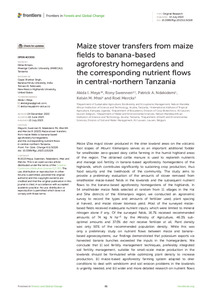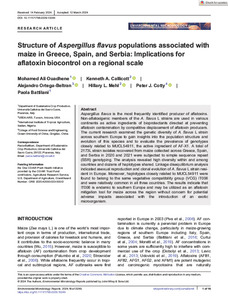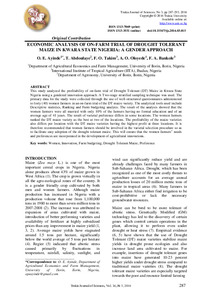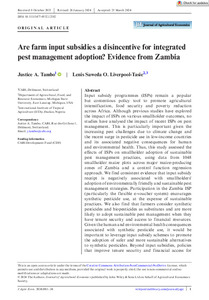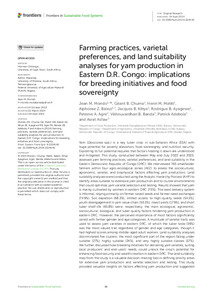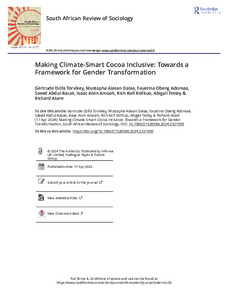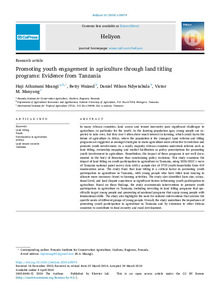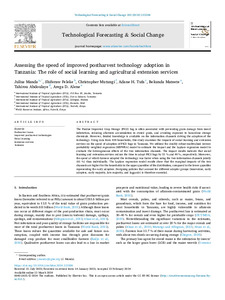Welcome to the International Institute of Tropical Agriculture Research Repository
Journal and Journal Articles: Recent submissions
Now showing items 121-140 of 5279
-
Maize stover transfers from maize fields to banana-based agroforestry homegardens and the corresponding nutrient flows in central-northern Tanzania
(2023-07-13)Maize (Zea mays) stover produced in the drier lowland areas on the volcanic foot slopes of Mount Kilimanjaro serves as an important additional fodder for smallholder zero-grazed dairy cattle farming in the humid highland areas of the region. The obtained cattle manure is used to replenish nutrients and manage soil fertility in banana-based agroforestry homegardens of the highlands, which contributes significantly to sustaining crop production, thus food security and the livelihoods of the community. ... -
Climate change adaptation strategies and its impact on household vulnerability to food insecurity: a micro-level evidence from Southwest Ethiopia
(2024-07-06)Smallholder farmers in Ethiopia face increasing challenges from climate change and variability, which threaten their food security and livelihoods. This study examines how adopting single and combined climate change adaptation practices affects their vulnerability to food insecurity in Bench Maji Zone, southwest Ethiopia. Through multistage sampling, data was gathered from 390 rural households in four climate-prone districts. The study examines the impacts resulting from both individual and combined ... -
Structure of Aspergillus flavus populations associated with maize in Greece, Spain, and Serbia: implications for aflatoxin biocontrol on a regional scale
(2024-04)Aspergillus flavus is the most frequently identified producer of aflatoxins. Non-aflatoxigenic members of the A. flavus L strains are used in various continents as active ingredients of bioprotectants directed at preventing aflatoxin contamination by competitive displacement of aflatoxin producers. The current research examined the genetic diversity of A. flavus L strain across southern Europe to gain insights into the population structure and evolution of this species and to evaluate the prevalence ... -
Economic analysis of on-farm trial of drought tolerant maize in Kwara state Nigeria: a gender approach
(2016-01)This study analyzed the profitability of on-farm trial of Drought Tolerant (DT) Maize in Kwara State Nigeria using a gendered innovation approach. A Two-stage stratified sampling technique was used. The primary data for the study were collected through the use of well-structured questionnaires administered to forty (40) women farmers in an on-farm trial of the DT maize variety. The analytical tools used include Descriptive statistics, Ranking and Farm budgeting analysis. The result of the analysis ... -
Are farm input subsidies a disincentive for integrated pest management adoption? Evidence from Zambia
(2024-04-23)Input subsidy programmes (ISPs) remain a popular but contentious policy tool to promote agricultural intensification, food security and poverty reduction across Africa. Although previous studies have explored the impact of ISPs on various smallholder outcomes, no studies have analysed the impact of recent ISPs on pest management. This is particularly important given the increasing pest challenges due to climate change and the recent surge in pesticide use in low-income countries and its associated ... -
Making genome editing a success story in Africa
(2024-03) -
Farming practices, varietal preferences, and land suitability analyses for yam production in Eastern D.R. Congo: implications for breeding initiatives and food sovereignty
(2024)Yam (Dioscorea spp.) is a key tuber crop in sub-Saharan Africa (SSA) with huge potential for poverty alleviation, food sovereignty, and nutrition security. Exploiting its full potential requires that factors holding it down are understood and mitigated. This study, conducted between May and July 2022 and 2023, assessed yam farming practices, varietal preferences, and land suitability in the Eastern Democratic Republic of Congo (DRC). We interviewed 765 smallholder farmers within four agro-ecological ... -
Smallholder farmers' willingness to pay for two-wheel tractor-based mechanisation services in Zambia and Zimbabwe
(2023)Mechanisation is back among top development policy priorities for transforming African smallholder agriculture. Yet previous and ongoing efforts ubiquitously suffer from lack of scientific information on end-user effective demand for different types of mechanical innovations to inform public investment or business development programmes. We assess smallholder farmers' willingness to pay (WTP) for two-wheel tractor (2WT)-based ripping, direct seeding and transportation using a random sample of 2800 ... -
Promoting youth engagement in agriculture through land titling programs: evidence from Tanzania
(2024-04-15)In many African countries, land access and tenure insecurity pose significant challenges to agriculture, in particular for the youth. As the farming population ages, young people are expected to take over, but they don’t often show much interest in farming, which could harm the future of agriculture in Africa, where the population is the youngest. Land reforms and titling programs are suggested as amongst strategies to make agriculture more attractive to investors and promote youth involvement. ... -
Soil quality reflects microbial resource availability and drives rhizosphere microbiome variation in Ghanaian cocoa farms
(2024-06)Cocoa (Theobroma cacao L.) is an important crop in Ghana and the source of livelihood for hundreds of thousands of smallholder farmers. Maintaining soil quality on these farms is critical to ensuring the long-term viability of cocoa farming and preventing deforestation to meet rising demand. However, increasing attention to soil health has revealed a significant knowledge gap related to the soil microbiome in cocoa production systems. Using a nested design of sixteen smallholder cocoa farms in ... -
Elite genotypes of water yam (Dioscorea alata) yield food product quality comparable to white yam (Dioscorea rotundata)
(2024-04-26)Water yam (Dioscorea alata), also known as winged yam, is one of the most economically significant yam species, serving as a staple food crop in tropical and subtropical regions. Its widespread cultivation is due to its favorable agronomic characteristics, including high yield, improved tuber storability, and significant nutritional and health benefits. Despite these advantages, water yam often remains underutilized due to consumer biases towards its traditional food product quality, particularly ... -
Making climate-smart cocoa inclusive: towards a framework for gender transformation
(2024)Climate-Smart Cocoa (CSC), a strategic offshoot of the wider Climate-Smart Agriculture, is gaining ground in Ghana, a cocoa export-dependent country. CSC is imperative, given the rapidly declining forests, prolonged periods of drought, pest and disease infestations, and fluctuating cocoa yields attributed to climate variability and change. Although many interventions are instituted to restore sustainable cocoa production, they are largely technicist because they do not pay attention to gender ... -
The pattern of genetic variability in a core collection of 2,021 cowpea accessions
(2024-05-06)Cowpea is a highly drought-adapted leguminous crop with great promise for improving agricultural sustainability and food security. Here, we report analyses derived from array-based genotyping of 2,021 accessions constituting a core subset of the world's largest cowpea collection, held at the International Institute of Tropical Agriculture (IITA) in Ibadan, Nigeria. We used this dataset to examine genetic variation and population structure in worldwide cowpea. We confirm that the primary pattern ... -
Farmer perspectives on desired catfish attributes in aquaculture systems in Nigeria. An exploratory focus group study
(2024-04-02)As a first step to determine the focus of potential genetic improvement programs for African catfish in Nigeria, we conducted a study to identify the preferred attributes among catfish producers across three states renowned for aquaculture production, in December 2022. Employing a qualitative approach, data were collected through 11 focus group discussions involving 123 participants. The findings indicate that farmers prioritize a range of catfish attributes related to both consumption and production. ... -
Genetic architecture of post-harvest tuber quality traits in bush yam (Dioscorea praehensilis Benth.) germplasm through association mapping
(2024-04-08)Introduction: Bush yam (Dioscorea praehensilis Benth.) is an important semi-domesticated food crop in West Africa. Limited information on the genetic architecture and its poor post-harvest tuber quality traits significantly hinder its use as food and source of income. Hence, dissecting the genetics underlying the expression of its post-harvest tuber quality traits is essential for establishing proper breeding schemes. Methods: In this study, 138 D. praehensilis accessions collected in Ghana ... -
Promoting youth engagement in agriculture through land titling programs: evidence from Tanzania
(2024-04-04)In many African countries, land access and tenure insecurity pose significant challenges to agriculture, in particular for the youth. As the farming population ages, young people are expected to take over, but they don't often show much interest in farming, which could harm the future of agriculture in Africa, where the population is the youngest. Land reforms and titling programs are suggested as amongst strategies to make agriculture more attractive to investors and promote youth involvement. ... -
Pollen amount and viability in Mchare and selected wild (AA) banana (Musa acuminata) genotypes: prospects for breeding
(2024-04-10)East African diploid cooking bananas, commonly called Mchare, are a staple crop for millions of subsistence farmers in Tanzania, particularly in the Pangani region in northern Tanzania. Several pathogens constrain Mchare production significantly and threaten food security. ... -
Assessing the speed of improved postharvest technology adoption in Tanzania: The role of social learning and agricultural extension services
(2024-03-12)The Purdue Improved Crop Storage (PICS) bag is often associated with preventing grain damage from insect infestation, reducing aflatoxin accumulation in stored grain, and avoiding exposure to hazardous storage chemicals. However, limited knowledge is available on the information channels driving the adoption of the technology. Using data from 429 households, this study examines the impacts of social learning and extension services on the speed of adoption of PICS bags in Tanzania. We utilized the ... -
Approaches and progress in breeding drought-tolerant maize hybrids for tropical lowlands in west and central Africa
(2024)Drought represents a significant production challenge to maize farmers in West and Central Africa, causing substantial economic losses. Breeders at the International Institute of Tropical Agriculture have therefore been developing drought-tolerant maize varieties to attain high grain yields in rainfed maize production zones. The present review provides a historical overview of the approaches used and progress made in developing drought-tolerant hybrids over the years. Breeders made a shift from a ...

